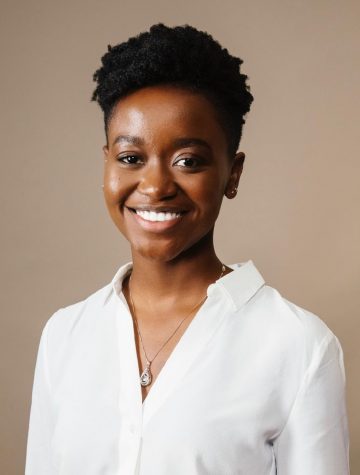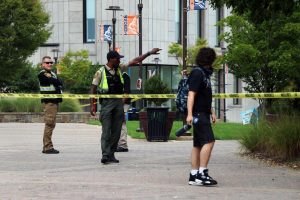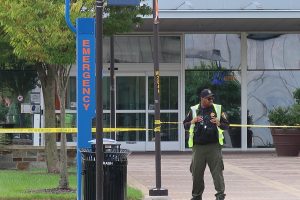A Conversation with University President David Wilson
Wilson gets candid in a tell-all interview about virtual campus life, the university budget and a potential spring 2020 opening plan
September 9, 2020
Around the beginning of this year, University President David Wilson, accompanied by other state leaders and CEOs, took multiple trips to China and Israel on HBCU business. That was the first time he heard of COVID-19.
At the time, news outlets had just begun reporting on the outbreak in Wuhan, and most Americans didn’t see the virus as a national threat yet. But Wilson had a bad feeling and he brought it up as soon as he returned.
“I returned here and had my cabinet meeting the next morning and the first thing that I did there was to start planning for ‘what ifs,’” he said. “So, if I had done anything differently, it would have been to absolutely demand that we would have perhaps aborted our study abroad programs earlier.”
The president’s cabinet members pushed back on Wilson’s initial concern and he agreed to wait two more weeks before revisiting the idea of bringing students back from their study abroad programs. In late February, the university blocked students from traveling abroad. By March, students were sent home to continue the rest of the spring semester online as COVID-19 cases soared in the U.S. and what was once perceived as a minor threat was declared a global pandemic by the World Health Organization.
Throughout the summer, university administrators held virtual town hall meetings with students and staff on whether or not to re-open campus this fall. Up until early August, Wilson was considering conditional face-to-face classes in a hybrid model where students and professors could decide whether they wanted to attend classes in-person or remotely. However, once it became clear that a COVID-19 testing frequency of multiple times a week could not be guaranteed and other colleges that had already re-opened their campuses had started seeing coronavirus outbreaks, Morgan announced its shift to online-only instruction for the fall semester of 2020.
“We felt that as the highest HBCU in Maryland and one of the highest-ranked HBCUs in the country that Morgan was not going to be a super spreader,” Wilson said.
In a one-on-one zoom interview between Wilson and The Spokesman’s editor-in-chief, we discussed his feelings behind the university’s ultimate decision, plans to address online-learning concerns and the possibility of returning to campus in the spring.
What was the process behind the ultimate decision to shift the fall semester of 2020 completely online?
Unfortunately, when you’re in a pandemic, you have to be nimble and you have to be in a position where even the best-laid plans must be revisited. And sometimes you have to make a decision at 9 a.m. and revisit that at 6 p.m.
Seeing how COVID-19 is behaving across the U.S. one could never make one decision and say, “we are going to stick with this decision regardless of consequences.”
And so, while I do understand that there may have been some frustration on the part of students…We have to really follow what we were seeing in terms of COVID-19.
Many colleges and universities that are closing for the semester will take a financial hit. What’s Morgan’s plan of recovery?
As we begin to dig into those numbers, we’re starting with a budget deficit of about $35 million. That is half of the revenue that we take in from students in terms of student tuition. When we have an operating budget of $275 million and you’re starting out with a $35 million hole, it is one of the most significant challenges that a university president can face.
So, we are working our way through that right now. I will be sending out a [message] next week to the university community, letting them know that this process is probably going to take about two and a half months. Then we’ll be able to report back what we are going to do to bring up budget and alignment.
Students have cited concerns with online learning, from turbulent at-home environments to learning disabilities. How have you and your team taken these considerations into account? What will be different this semester?
I learned a lot about some of the environments in which our students were trying to digest high-level college instruction.
What we and other institutions across the country are learning is that COVID-19 is causing so much stress on students and on their families. Many of our students, unfortunately, are dealing with the loss of a relative, the loss of the relative of a friend, the loss of friends and because of that, they are dealing with perhaps loss of income in their families where mom or dad, or grandma and granddad or whomever, their guardian lost your job and so it’s a lot of stress.
As a result, even in the financial crunch that we are in, I have made a decision to invest in our counseling center and to hire two more professional counselors that will be available to help our students to reflect on and process all of the stressors.
How are you working to secure housing for students with extenuating circumstances? What qualifies as an extenuating circumstance?
We value our global footprint, so our international students would be on the list of extenuating circumstances. We had about 300 students who have resided here on campus throughout the spring who also fit that same definition of extenuating circumstances.
Students send me a lot of emails about their conditions and I read every last one of them and some of them bring me to tears in terms of the circumstances in which they find themselves in their homes and their communities.
They pour their heart out to me.
If it were left up to me, I would have them all back, but that’s not a decision I can make and be assured that it’d be a safe one. We have set up a very caring, very thoughtful group of colleagues of about three or four here on campus to look at all of the emails, all of the applications that will come in and look at everything from, home environments to the way students, perhaps, need the embrace of a smaller community for emotional support and other factors as well.
How does the university plan to maintain a sense of community online?
We have some amazingly creative and innovative colleagues here at Morgan to ensure that we can carry on as many of these traditions virtually as we possibly can.
Even with our athletics department in discussions with Athletic Director Edward Scott, we are working on a virtual football game if you can believe it. It’s guaranteed that Morgan is going to win [laughs]. Then, we’ll find a way to put some footage of last year’s Homecoming parade and the festivities and kind of create, even though we may not be on campus physically, this whole spirit of what Morgan is. At this particular point, we will start planning with the expectation that we will have face-to-face here on campus in the spring and I think that is a function of what we are seeing in the testing environment.
What are some factors that a face-to-face spring semester would be contingent upon?
We will have to plan for a spring 2021 reopening, and I think that plan is going to be similar to the one that we had in fall, the hybrid plan. The major factor here is going to be where the virus is and whether a vaccine has been approved, the comfort level in various communities in taking the vaccine and whether we have an abundance of service tests available where we can test quickly and get results in a matter of minutes.
How will the cost to attend Morgan change now that we’re online only?
Morgan still is, in terms of tuition, the second-lowest in the state of Maryland. Our tuition is about $8,000 a year. What we have done here is that we were the first institution to decide that we were not going to increase tuition. We further decided that for students that are studying completely remotely this fall and are not living in university housing, they will not have to pay room or dining fees. So, you’re eliminating another $4,000 or so off of your bill.
Further, we are reducing fees by 15 percent. The normal cost for an in-state student to come to Morgan per year is about $16,000. That’s about $8,000 total per semester. If you’re shaving that in half because now, you’re not paying room and board fees and you’re paying 15 percent less on the other fees, a student now can come here in the fall semester for somewhere in the $4,500 range.
This particular semester will go down as one of the least expensive for students in Morgan’s contemporary history.
To check out the full interview, click here











